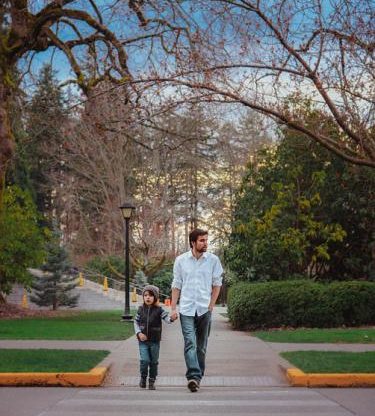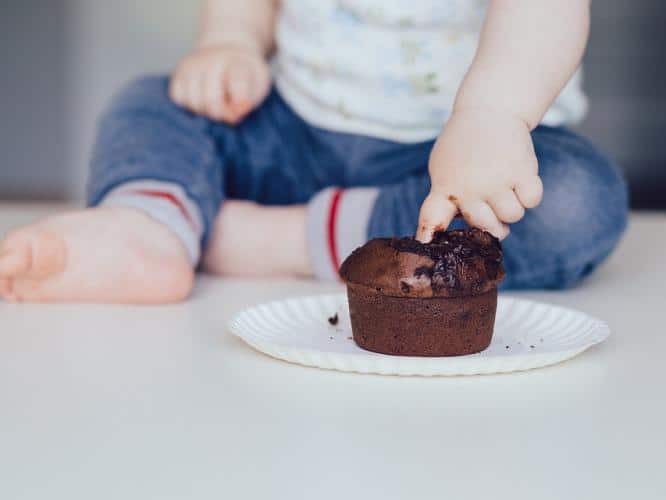Teaching Mindfulness to kids is the best way to help them face societal and social media intrusion. Kids today are overstressed and exhausted and forget to live in the moment without the knowhow on how to handle their emotions. Thus, mindfulness games are used as a tool to make kids be present in the now, develop awareness about their mind, body, soul and environment. Remember, being mindful does not erase troubles from their lives. But, gives them options other than anger, fear, stress, and disconnectedness to choose from. Thus emerges a calmer sensitive individual.
Aren’t these just too many benefits under one umbrella!
I am sure it has got you wondering how to teach mindfulness to kids and that too early?
Well, here are 12 Simple and Fun Ways of Teaching Mindfulness to Kids as per their age-group.
12 Simple and Fun Way of Teaching Mindfulness Games to Kids from 2-16 years
I. Just Fly Away
It is difficult to grasp the attention of toddlers, let alone teaching mindfulness. When your toddler feels cranky and sad, use a little distraction. Instead of a board or computer game, play with them by blowing bubbles. You could use terms like ‘Bye-bye Sad Bubbles’ or ‘Fly away Tears’. A gesture to connect with letting go. The toddler might not understand it right away however it lays the foundation of dealing with stress.
Tip – Make sure you use Non-Toxic Bubbles for a safe experience best suited to Toddlers while playing the mindfulness game.
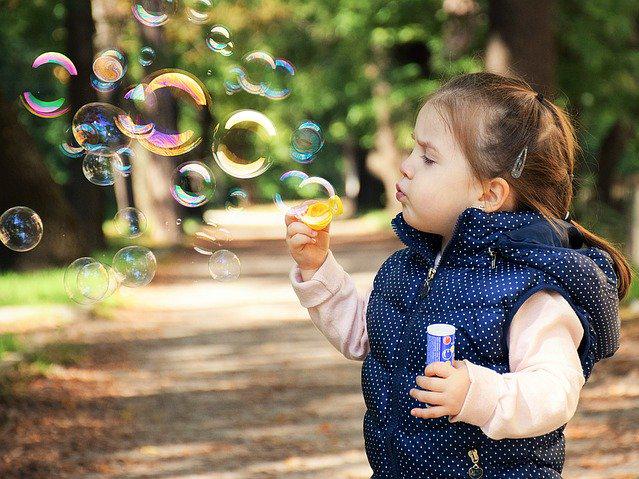
II. Catch It – if you can
Teaching mindfulness to kids can be fun and meaningful at the same time.
Catch It – If you Can: is for your kids who are super active at home or in school. During the beginning of the activity, you give each kid a balloon with the idea to let the balloon float in the air and not touch the ground. Since the balloon is fragile both the parents and kid’s minds are on an alert while playing with the Balloon. Thus, the mindfulness game increases the ability to focus and concentrate.
Tip – It is an activity meant for 2-7 years, age group.
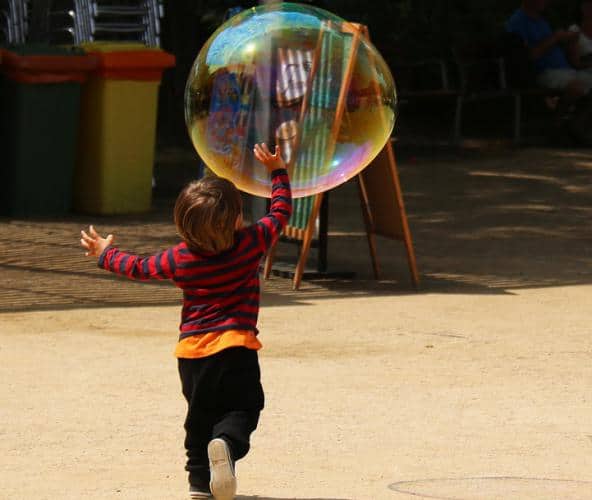
It is a herculean task to make 9-12 years sit in one position for any length of time. An age when they are restless with a low attention span. Also, at this age that they start interpreting emotions, thoughts and building awareness on how these affect others. Thus, a perfect age to introduce mindfulness games and techniques.
III. Breathe Like a Whale
After you make your child sit in whatever position they are comfortable in (preferably cross-legged) – draw their attention to the feeling of the breath on their upper lip. Next, guide them into taking a deep breath and hold the breath for as long as they comfortably can. The deeper they breathe in the longer they can hold their breath. If you have more than one child – this mindfulness game becomes even more interesting.
Children love to compete and they can exchange notes on who can hold their breath longest. It is an easy fun way to help them pay attention to their breath. You could also do this with soft music playing in the background. The one who can hold the breath longest should be awarded the Whale of the Day tag!
Tip: Before the activity remember to show the kids a picture of a Cuvier Beaked Whale who has a record of holding its breath for 138 minutes underwater. Kids who practise Swimming will naturally find this activity easier.
Breathwork is a fantastic and extremely beneficial mindfulness tool that accentuates focus, alertness, reduces stress and anxiety in kids. Kira Willey, a kid’s yoga expert and trainer says – yoga and mindfulness through music are known to improve their school performance and overall behaviour. Watch her Ted Talk called Bite-Sized Mindfulness.
IV. Turn Into a Starfish for Mindfulness
The Starfish Mindfulness Game – is a breathing technique where you ask your child to hold up one hand in a starfish position (all fingers spread wide) in front of them. And, use the other hand to trace up and down each finger with the other hand. Moreover, as they go one finger up, tell them to breathe in and as they go down the finger, breath out.
Tip: You can turn Kids into Starfish ranging from 3-9 years
V. Breathing Buddies – Teaching MIndfulness to kids
An easy and fun way to teach kids mindfulness through playing games is by using Breathing Buddies. The practice of Breathing Buddies makes meditation friendlier and fun. David Goleman, a renowned author in his video describes how Breathing Buddy brought about compassion and empathy among 2nd-grade students.
Step 1:
Hand out your kid’s favourite stuffed toy after they lie flat on their back. Let them place this toy on their tummies with their eyes shut.
Step 2:
Next, all of them inhale deep while they expand their bellies as much as they can while noticing how their breathing buddy is moving up and down their bellies. If their toy falls off their belly laugh with them and help them place it back on their bellies.
Step 3:
Now help them pay attention to other sensation as they breathe. They may feel a tingling sensation in their toes due to the excitement of the activity or just feel the soft or warmth of the rug on which they are lying down or the furry feel of their buddy on their tummies.
Step 4:
Let them focus their attention only on their breathing buddies and eventually with practising the other thoughts that come to their minds, will turn into bubbles and float away. Therefore, the mindfulness game helps them to clear their minds.
Tip: You could do this Mindful Activity within the age of 9-13-year-old kids.

VII. Rack up Your Mind with Jenga
Jenga is widely used for teaching mindfulness to kids all over the world. You can find Jenga as a mindfulness game in playschools, cafes and even on coffee tables at home. Since it can be played by big and small all age groups it is a huge activity to bond and yet be mindful.
On each block of Jenga write one question, prompt or affirmation.
For example:
“I am an Angel with Wings – Answer Why?”
What are you feeling in this moment-SAD, MAD or GLAD?”
“What is the Most Thankful Moment of my Life?
Laugh Your Loudest and Funniest Laughter”.
Then, each child pulls out a Jenga block and answers the prompt or question. Thus, the game will help them to be open to sharing and encourage positive behaviour and also have emotional control.
Tip: Make sure there is a parent or trainer around to guide the kids while they play the game to steer kids to develop mindfulness through the activity.
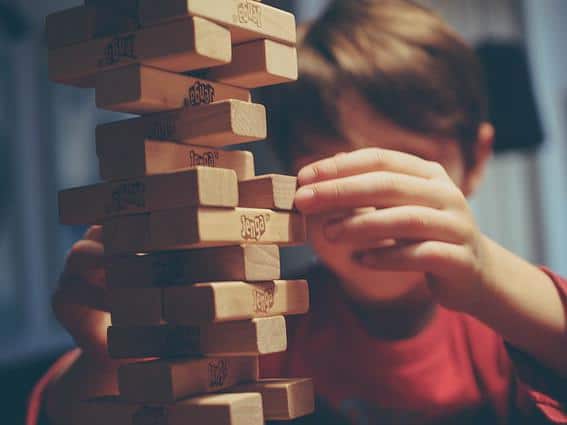
VIII. The Bell Trick
A very fun way of teaching mindfulness to kids is the Bell Trick meant for all age groups. Light some incense sticks, candles or a camphor lamp with low lights to create an ambience. Now simply ring a bell, singing bowl, a set of chimes or a sound app to create notes floating in the air for 30- 60 seconds.
Step1:
Ask the kids to take a sheet of paper and write down what they can hear before the activity begins.
Step 2:
Every participant is meant to pay attention to the sound of the Chimes or Bells until they stop ringing. To avoid distraction you could even request them to close their eyes while listening.
Step 3:
After you stop the bells ringing – ask them to start noticing the ambience sound around them – like the buzzing of the car engine down the street, or the voices of people from the next class, or the gentle rustling of the leaves in the wind (in case you are outdoors).
Step 4:
In the end, let the participants start noting down the sounds they have started noticing and compare them with the sounds they noticed before the Bell Trick.
Thus, you help them develop mindfulness to sound, become more attentive, minds become more alert and boost memory power. Also, mindfulness games help them identify various kind of sounds, music and noises present in their surroundings.
Tip: The best place to conduct this activity is in the Music or Play Room or even outdoors sitting amidst nature.

VIII. Jar-full of glitters
This mindfulness game activity is meaningful and deep, yet the best way of teaching mindfulness to kids of age groups between 9-12 years old. It will help them to understand any strong emotion they emote and how to resolve and find peace within.
Step 1:
Take an empty and clear jar and fill it up with water.
Step 2:
Add a spoonful of glue and glitter to the jar and shake it till the glitter begins to swirl.
Step 3:
Tell your kids – “Imagine the glitter in the jar to be your thoughts, feelings, and emotions of those when you are sad, stressed or upset. See, how hard it is to see clearly? Thus, it is easy to make rash decisions when you are upset as you don’t think straight. Well, this is normal. Yes, it happens with adults too.”
Then bring them to notice how the glitter begins to settle when the jar is kept still for a few seconds and the water begins to clear up. In the same manner, when you are in a calm state of mind, your thoughts become clearer. Also, taking deep breaths helps to calm your emotions down and relaxes your mind.
This mindful activity helps kids to understand their emotions clearly and what consequences it can lead to. It facilitates the practice of mindfulness in kids.
Tip – If you use a glass jar then it is best to keep it out of reach from kids and also, tighten the jar to avoid water spilling out.

IX. Food Riddles – Mindful Learning
Most of the youngsters are glued on their TV screens or Smart Phones while eating while their parents are cooking. Thus, the knowledge of observing and learning food items and how they are cooked is becoming obsolete. Understanding what they eat and how is it cooked is another way of teaching mindfulness to kids.
Creativity is required in triggering the attention of the millennial kids. Often a challenge for parents and trainers. Thus, I have listed some creative methods to understand and remember the food we grow, cook and eat.
Method 1: Recognise what You See?
You could play a mindfulness game with the kids by placing one piece of raw vegetable in their lunch box matching to the ingredient used while cooking. Ask them to return the lunch box with the raw ingredient after school and tell you what they ate that day and describe how it looks versus the raw version.
Celebrity Chef and Youtuber Jamie Oliver shocked the audience in his Ted talk on food. He showed videos of kids not being able to recognise or name simple fruits and vegetables like Cauliflower, Tomatoes, Potatoes or Beetroot. Click here to watch Full Video. It re-instates the importance of teaching mindfulness to kids not just about the food on their tables, but also about how it is grown and cooked.
Method 2: Design a Placemat
Indulge in doing something creative. Design a Placement together with your child as an effective mindfulness game.
Start with cutting out pictures from food magazines or just photoshop them on a blank sheet on your computer screens. Label or write headers on 4 sheets.
Label them as:
- Food Grain Products
- Fruits and Vegetables
- Milk and other Options
- Meat and other Options
Either glue or photoshop the food pictures on all food Food Groups respectively. It will instantly increase awareness and recognition of items under the four labels in children who are involved in this mindful game.
Method 3: Plant a Herb or Vegetable
Holidays are the best time to teach mindfulness to kids through this activity.
Firstly, take a clay or porcelain pot and make sure there is a hole in the bottom. Now help your child fill it half with soil.
Secondly, let those tiny hands feel excited as they plant seeds/saplings of herbs, vegetables or fruits. Fill the rest of the pot with the remaining soil. Water them a little bit each day. keep them in a sunny or shady spot as per the weather and instructions.
Lastly, watch them grow each day into little saplings and grow into plants and eventually into fruits or veggies. Make a little folder or video on your phone or Instagram handle capturing weekly pictures of the plants grow. Mix a video later to enjoy the process and sense of achievement.
Thus, you build awareness in the kids about the patience and perseverance required to grow anything mindfully. They learn compassion when some seeds do not grow as healthy as the others. Talk to them about how nature is our best teachers. When they plant a new sapling because the old one failed to grow – they learn how to accept failures as just another step towards achieving their goals.
Tip: Parents are advised to practice kitchen gardening mindfulness game as well. Because kids tend to watch and learn what parents do.
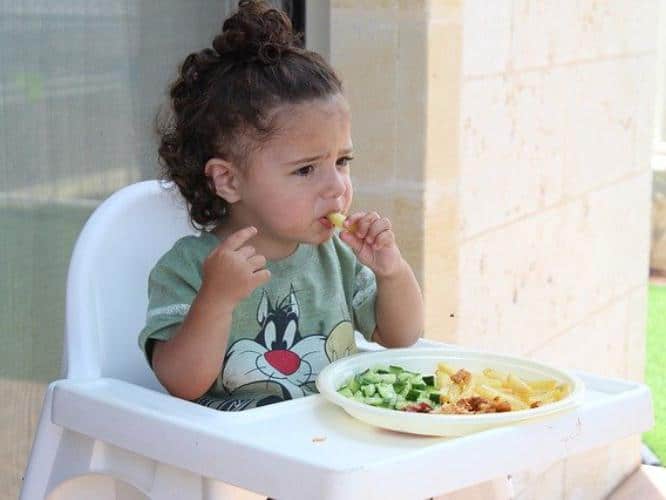
X. MIND YOUR WALK – A Practice to Build Mindfulness in Kids
Taking your kids for a Mindful game or activity can be turned into a discovery walk they look forward to. It can be played as an activity after dinner when your children’s cousins or friends come for a sleepover.
On a sheet of paper let them write what they see as they walk. End of the walk, hand them another sheet on which you wrote ten things they probably would not have noticed. The fun element is for them to compare the two sheets and find out what they overlooked. This triggers them to pay attention to many things they may have failed to notice. It teaches them to be alive and be fully present NOW. They start becoming aware of the different species of trees, the little snowflakes on their coat, the rusty car standing next doors, kids zipping past on their cycles and much more.
You can also, go back and walk again and show them what they have missed out on. No wonder the Japanese therapy of Forest Bathing is becoming popular as a method to – develop mindfulness.

XI. Touch and TEll – TO be Mindful
It is an age-old activity most of us played as we grew up. I find it very useful thus find it worth mentioning here. The idea to teach mindfulness to kids is by making them dig their hands in a no-see-through bag full of various objects. The objects could be of various, size, shape, texture and usage. Think out-of-the-box and fill in common stuff yet recognizable. Give them a time limit to feel and touch the objects one by one.
Lastly, within a given time limit each participant is to write the list of items they assume were in the bag. See how many objects each one of them got correct. The fun is to see strange descriptions emerge due to not being able to see the objects. Moreover, it makes you end up laughing and wanting to do more of the same activity.
Tip: Avoid any sharp object in the bag to avoid any kind of injury or scratch. Say a big no to removing any object out of the bag before you start the mindful game.
Variation to the Above Activity:
You can also blindfold each child and explore different smells letting them describe what kind of smell it is and how it makes them feel. For example, burn a lamp diffuser with essential oils or place a food item in front of them like baked cookies. Thus, helping them develop a sense of smell and touch and boosts concentration and memory.
XII. Practice Gratitude
Teaching mindfulness to kids through gratitude will encourage them to appreciate the little joys of life they experience. Incorporate the practice by placing a Gratitude Jar on the centre-table of your living room. Add a few post-it slips with a pen next to it. Everyone at home after dinner is to write one thing they are grateful for and insert it in the jar. Then, at the end of the day, empty the jar and sit around the table and read out the Gratitude Slips aloud. Do this for a fortnight to begin with and see how it changes the attitude of each family member.
A simple mindful game or activity can trigger so many emotions followed by surprises, hugging and tears of joy. It aids in developing an attitude of Gratitude and a sense of love and caring for those around you. Thus, Gratitude reduces aggressive behaviour and bullying that children often face or practice at home or in school.
You can also slip in thankful notes in their lunch box or tell them bed-time tales on gratitude. For more on Gratitude Read the Science behind Gratitude.
Tip – Do not place the jar in the hands of the kids if it is breakable. You could also use a non-breakable bowl to use.

Take-Home
Mindfulness games to build awareness is the dire need of the hour. There is a staggering figure of the obesity epidemic alone accounting for an estimated 300,000 fatalities per year. Thus, the need for mindfulness to live a healthier life is imperative in today’s world. Depression and suicide are the third highest leading cause of death in teenagers between 15-19 years.As per WHO “The consequences of not addressing adolescent mental health conditions extend to adulthood, impairing both physical and mental health and limiting opportunities to lead fulfilling lives as adults.”
An earlier study shows a “mindfulness-based universal health promotion program called the Life Balance program prevented the emergence of new psychological symptoms in 1 of every 16 people treated at one year follow up”. With so many feathers up its cap teaching mindfulness to kids is the even more important than sending your children to school. I would say – it is the one way to save humanity from getting extinct.
Related Articles:
Mindful Eating Methods – for Weight Loss
What is Mindfulness? Benefits of Mindfulness


